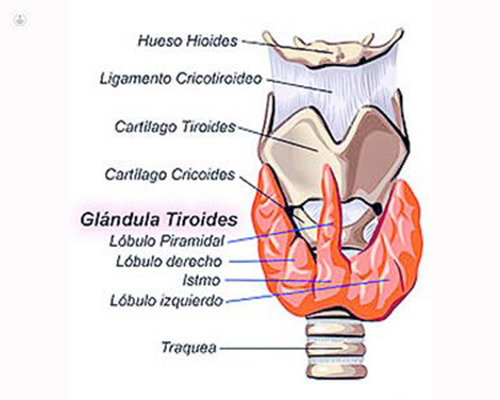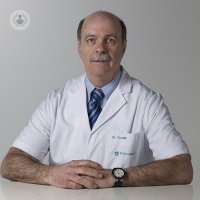Excision of thyroid gland
Written by:The thyroid gland is shaped like a butterfly and has an endocrine function, this means that the hormones it produces are poured directly into the blood, being under the direct control of the pituitary gland that is located in the Turkish saddle of our skull. It is located in the neck in close relationship with the trachea and below the thyroid cartilage or walnut bone.
As every gland has the ability to become entangled or hypertrophied, to present benign nodules that function more than normal, canceling the rest of the gland or solitary nodules that do not work.
Also the gland can secrete more than normal leading to hyperthyroidism (Graves-Basedow disease) that will require treatment. When the nodules occupy the two lobes, they give rise to a multinodular goiter. As in all the organs of our body can cause malignant tumors.
The intervention
Ultrasonography and cytological puncture (FNA) are the two essential tests prior to surgical indication. Once performed, surgical removal is carried out. This can be limited to one lobe as long as the lesion is unique and benign. In all other cases, thyroidectomy is total or almost total.
It is indicated in the following cases:
- Lonely benign nodule with a size greater than 30 mm and / or that the cytology obtained by puncture observes a moderate or high cellularity. Either of the two circumstances is sufficient to advise surgical excision.

- Multinodular goiter with nodules that meet the above conditions.
- Hyperfunctioning thyroid that can not be controlled medically.
Whenever there is suspicion or confirmation of a neoplastic process.
The main symptom is the existence of a nodule in the neck, although other ways of detecting thyroid diseases is the evidence of an analytical alteration of the T3 and T4 hormones requested in analyzes prior to treatment of obesity or infertility.
Thyroid surgery presents two key points that are the preservation of the parathyroid glands, which are in number four and in intimate contact with the posterior wall of the thyroid, and visualization not to injure the recurrent laryngeal nerve, which innervates the cords vowels and their injury results in temporary or permanent aphonia depending on the extent of the injury. It is necessary to check that there is no bleeding in the first hours after surgery.
Post-operative and recovery
The postoperative period is usually quick and painless. Sometimes patients complain of cervical pain due to the hyperextension to which the neck is subjected during surgery.
Usually, patients who have undergone partial resection (hemithyroidectomy) are discharged after 24 hours. On the other hand, if they have undergone a total or subtotal thyroidectomy, they are discharged after 48 hours, after checking correct calcemia..
It is important to take care of the scar. The patient is either treated with an intradermal suture, so there is no need to remove stitches, or the suture is made with a single non-absorbable stitch and it will be removed after 10 days.. Being an area very exposed to the sun should take care of it with silicone patches or high protection sun creams. In cases of total thyroidectomy, replacement therapy with oral thyroid hormone is initiated.



